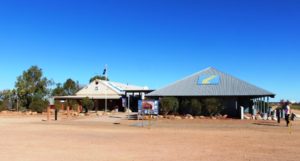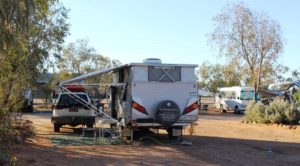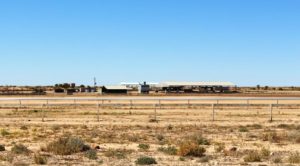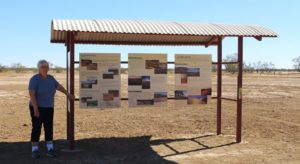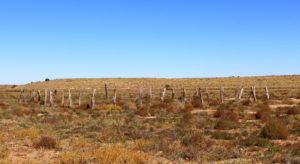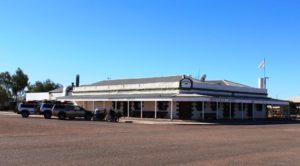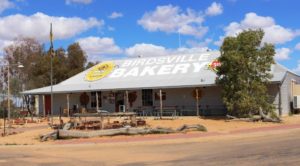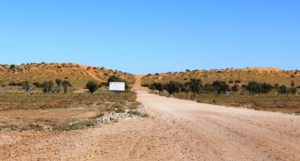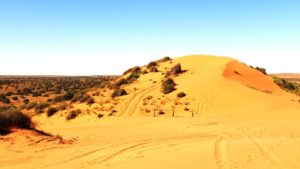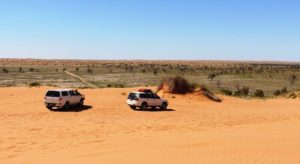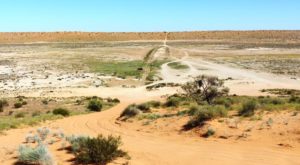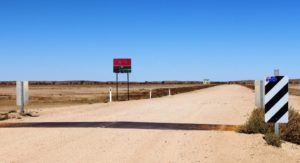We had problems in finding a place to park out van in the small caravan park in Bedourie. Enthusiastic watering to produce grass had turned most of it into a quagmire. It doesn’t take much water to create a bog hole in this country.
But there was no such pretense at Birdsville Caravan Park. It is an orderly, well kept park but there is not a blade of grass in sight. Fence to fence it is compacted fine gravel. The events that draw large crowds here, particularly the Birdsville race meeting and the Big Red Bash, have made it necessary that the park be able to handle crowds. The amenity block is sized accordingly. The races are less than three weeks away, so preparations for the crowds are under way.
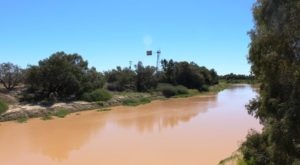
The Diamantina River at Birdsville. Water levels are rising as the recent rains to the north slowly move towards Lake Eyre
Our Monday activity was to have been a trip to the Big Red sand dune on the edge of the Simpson Desert, but no sooner had we left town than out navigation system stopped showing us the way. This necessitated a return to camp to fix the problem. While I puzzled over the problem Ruth started some washing. By the time that we were ready to go it was a bit late, so we had lunch and set off to see closer sights.
Just over the Diamantina River there still stands a tree into which explorers Bourke and Wills cut a blaze and chiseled some markings. Look carefully and you can see parts of some of the characters that they cut, still visible after more than 150 years.
Right next door are the facilities for horse trainers, probably built here for proximity to the river. A little further from town the race course itself is located beside the highway, which is the northern end of the Birdsville Track. Preparation is also under way there.
There is still a temptation to change our plans and go down the Track, so we drove the first 30 kilometres to gauge its condition. It is a full width gravel road and is in quite good nick at this end. Just some more grist for the decision mill.
The drive took us over the South Australia border, which is only 15 kilometres south of Birdsville. By the time that we turned around we were well into the long sand dunes that cross the country side. The border is well sign posted by both states and an
Tuesday dawned, another cloudless day with a cool easterly breeze and flies. We made a fairly early start on the 35 kilometre drive into the edge of the Simpson Desert, arriving at the boundary of the National Park at about 10.00 am. Since the authorities had provided a picnic shelter there, the last one until the other side of the desert probably, we shared it with a family of Swallows that had built their nest in the roof frame.
The sand dune known as Big Red is the tallest sand dune in the Simpson Desert. In reality it is the highest spot on a sand dune that disappears into infinity in both directions. The dune could be over one hundred kilometres long. A couple of kilometres to the south, part of the same dune, is Little Red. The road leads directly to Little Red which you can cross and continue on into the desert. Or you can turn right and follow the foot of the dune until you come to Big Red.
To drive over Little Red is a bit of an anticlimax. To drive to the summit of Big Red is one of the most iconic things that a four wheel drive enthusiast can do.
We parked at the foot of Little Red and I climbed to the summit along with two or three other people. We then drove to the foot of Big Red. Again I climbed to the summit and discussed matters with another driver who had taken the walk just before I did. We decided to reduce tyre air pressure, as recommended, and give it a try. I offered to video his ascent and did. He then took my camera as I returned to the car, reduced air pressure and made the climb. We ascended without problem. Another item ticked off the bucket list!
We agreed that the drive up the dune had been easy and wondered what all the fuss was about. Then we looked over the western edge and understood. Because of prevailing easterly winds most of the loose sand has been blown from the eastern side to the western side of the dune. Those travelling in an easterly direction face piles of soft sand, fluffed up by the wind. We watched as two drivers struggled with the conditions. They were still struggling when we drove back down the dune, re inflated our tyres and returned to town.
It was now lunch time. Another iconic activity in Birdsville is to eat a curried camel pie at the Birdsville Bakery. Ruth chickened and had ordinary beef. We washed them down with cappuccinos. The curried camel was not bad. It tasted a bit like beef but with a distinct difference. The accompanying picture will explain.
That left us with one last traditional activity before leaving Birdsville. A drink at the very historic and dare I say it, iconic Birdsville Hotel. We arrived at the same time as two of our fellow adventurers from this morning’s activity at Big Red. So we joined them and chatted about the kind of things that folk chat about under such circumstances.
For William Shakespeare the big question was to be or not to be. For us it was to go or not to go. Here we are at the northern end of the Birdsville Track and one of my ambitions has always been to drive its length. But if we do that we will arrive in the Flinders Ranges to a succession of 4 degree mornings and several following that will, in all probability, won’t be much warmer . That makes it a no brainer. Tomorrow we will retrace our course back to Boulia and from there to Mount Isa and points west. And ultimately south, but only after minimum daily temperatures increase a bit, hopefully.

